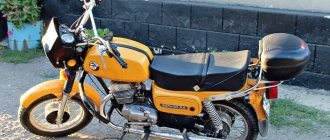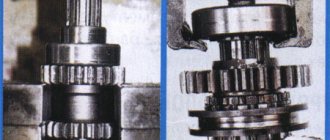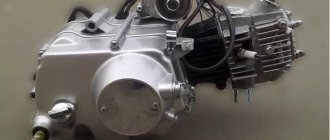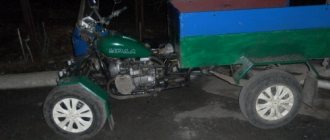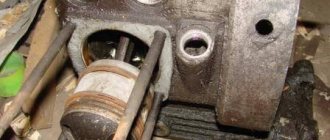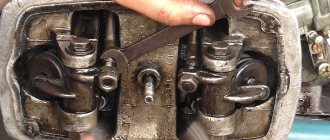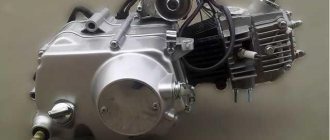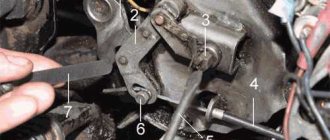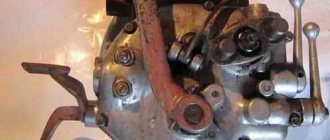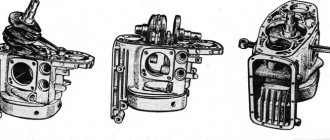A motorcycle, like any other equipment, requires careful handling. Improper management not only entails financial costs, but can also lead to emergency situations. As in cars and motorcycles, correct gear shifting increases the operating time of the device. Inept gear changes cause premature wear of the gearbox. This may result in other problems: inability to switch to certain gears, knocking in the box, etc.
Improper control of a motorcycle can lead to accidents.
All these problems lead to rapid wear of the clutch discs, wear of the clutch basket, chafing of cables, etc. Which, in turn, leads to the replacement of these parts, repairs and adjustments at the service center.
Therefore, it is highly advisable to understand the gear shift system and the features of your particular model.
Gearbox in a motorcycle and its purpose
Due to a design flaw in the internal combustion engine, it became necessary to adjust the rotation speeds of the engine and wheels. This function is performed by the transmission. The main types of transmission are mechanical and automatic.
Modern production motorcycles mainly use manual transmission. Automatic transmission on motorcycles is still a rarity. But bikes such as the Aprilia Mana-850 or, say, the Honda DN-01 can boast an automatic transmission.
Video tutorial on changing gears on a motorcycle
In short, a gearbox is a set of gears that change the frequency and torque of the drive wheels. At constant crankshaft speeds, this mechanism changes the traction forces of the rear wheel of the motorcycle.
Depending on the design, the motorcycle is equipped with a gearbox with a different number of steps (gears). Each individual combination of transmission gear meshing is called a gear (stage). The number of gears depends on the design of the motorcycle. There are 2-, 3-, 4-speed gearboxes, etc. In motorcycles with sidecars, as well as three- and four-wheeled motorcycles, manufacturers have installed a reverse gear, thereby ensuring the ease of driving this type of transport.
The manual gearbox (gearbox, gearbox) is constantly being improved. But its purpose has not changed over time. It is needed to optimize the operating mode in various conditions by changing the gear ratio. In order to change the speed, it is necessary to change the traction force on the wheel, that is, switch - up or down the gear. Therefore, sometimes the gearbox is also called a gearbox.
Ural gearbox switching diagram. Ural 4320 gearbox shift diagram
Depending on the car model, the control scheme and location of transmission gears on the new KamAZ may differ. Domestic trucks can be equipped with two types of gearboxes.
The difference is that some transmissions have five shift stages, while others have ten. These models are called 14 and 15. Five-speed transmissions are usually installed in cars that are used as personal vehicles.
Ten-speed gearboxes are usually equipped with trucks classified as road trains.
If you are driving downhill, you do not need to turn off the engine. When the engine is turned off, the steering wheel will lock. And this will lead to an emergency on the road.
When driving downhill, do not turn off the auxiliary braking, and also depress the clutch pedal all the way.
Newer versions of trucks use improved transmissions, which has allowed engineers to reduce the load on the main gearbox parts. Therefore, when driving in critical conditions and on descents, the car’s engine will not wear out.
How to change gears on a Ural motorcycle
This is the peculiarity of driving a KamAZ vehicle. A gearbox, the shift pattern of which is well studied and executed in this form, is distinguished by directional stability.
The main point of dividing it into 2 modes is to facilitate engine operation when driving a car with different weights.
Starting off on a loaded KamAZ (or with a trailer) is carried out in high gear with a crankshaft speed of 2600 rpm.
Please note => Documents Necessary for Registration of Ownership of an Apartment
Purpose, design and operation of the gear divider
The gear shift mechanism of the divider is designed to ensure that the required gear is engaged while the vehicle is moving and consists of a fork 14 (see Fig. 17) with nuts 15, a roller 13 of the fork 14, at the end of which a lever 16 is installed, and a pneumatic cylinder with a gear shift mechanism housing.
We recommend reading: Deed of gift with the right of lifelong residence
1 - spring housing; 2 — intake valve spring; 3 - gasket; 4 — inlet valve; 5 — intake valve stem; 6 — body; 7 — union nut; 8 - membrane; 9 — washer; 10 — housing cover; 11 — balancing spring; 12 – plug
Transfer case Ural 4320, design and operation
Today we will talk about the transfer case of the Ural 5557 and 4320, and also discuss their design.
The transfer case is a unit that is responsible for distributing torque from the engine to certain drive mechanisms, and they most often increase the number of gears in the transmission.
The Ural transfer case distributes torque between the axles and increases the torque of the drive wheels, which guarantees stability while the Ural vehicle is moving.
The Ural transfer case significantly affects the cost of the fuel mixture and the traction and speed parameters of the vehicle.
Because of this, the cost of transporting various cargo directly depends on the correct choice of parameters owned by the transfer case itself.
Ural 5557
In this article you can easily find answers to the most common questions:
- Transfer case of the Ural 5557, 4320 and its device;
- Functioning of the part as a transfer case of the Ural 5557, 4320;
- Common malfunctions of the transfer case of the Ural 4320, 5557;
- Adjusting the transfer case of the Ural 5557 and 4320.
Basic information about the transfer case of the Ural 5557 and 4320
The Ural 4230 and 5557 vehicles use a two-stage transfer case equipped with an asymmetrical cylindrical center locking differential with a power drive. The transfer case is mounted on the car frame using four rubber pads. The design of the transfer case of the Ural 5557 and 4320 is absolutely the same as that of the KamAZ 4310.
In the middle of the crankcase the following are located on bearings:
- Intermediate roller with gears of the lowest high gear;
- Rear drive shaft with middle axle. An asymmetrical cylindrical center differential is installed on these rollers;
- Front axle drive shaft;
- The primary roller has high and low gears, and a clutch is installed between them to change gears.
In order to maintain atmospheric pressure in the crankcase cavity, a fitting with a tube is installed on the bearing cover, connecting the crankcase to the atmosphere through a sealing system. The outlet tip of the tube is brought to a level above the maximum fordability to prevent water from being sucked into the crankcase while overcoming water obstacles.
The crankcase is made of cast iron, there is a hatch on top, the crankcase itself is one-piece, closed with a lid with an oil guide tray.
Oil is poured into the crankcase through the top hatch with the cover removed or through the hole under the control plug, which is located on the rear wall of the crankcase. The oil is drained through the bottom hole, which is closed with a plug with a magnet.
The crankcase is ventilated using a fitting, and its tube is included in the general sealing system of the units.
What you need to know about broadcasts
Motorcycles are equipped with a sequential or sequential gearbox
First of all, you need to study the “controls” of the motor vehicle. Management will depend on their structure. Motorcycles, for the most part, are equipped with a sequential (sequential) gearbox. The name itself hints that the speeds are switched sequentially, without skipping steps. For example, to switch to fourth from second, you should first switch to third, and only then to fourth. This makes driving easier.
The process of controlling the gearbox on a motorcycle occurs through the action of the driver’s foot on the installed lever. In turn, this feature requires significant attention on the road. There should be no confusion with gears; this may have a negative impact on traffic safety.
DIY clutch repair
Repair after disassembly - inspect its parts and replace if necessary. Clutch springs should not differ from each other in height by more than 2.5 mm. If the friction linings of the driven discs are severely worn or damaged, they should be replaced (re-riveting the linings). Riveting can be done using fixture 2 or mandrels 3 (picture) in the following order:
- knock out the rivets with a beard and remove previously installed unusable linings; — place new linings 1 on the disk so that the countersink holes of both linings are on the outside; — insert hollow rivets 4 one by one into the holes and spread their ends apart with a core 5, hitting it with a hammer 6, while the heads of the rivets should be buried in the countersinks by at least 1-1.5 mm.
Sequencing
On most motorcycles, the driver adjusts the clutch manually using a lever located near the left handlebar grip. This transmission is installed on the Ural and Minsk motorcycles. To change gears in these models you must follow the sequence:
- Place the motorcycle in neutral and start the engine.
- Shift into first gear (remove the gas, depress the clutch, press the gear shift pedal, release the clutch and gear change pedal).
- Add gas. And then we increase and increase the gears.
In other words, when the gear increases, the actions described in point two are repeated.
On motorcycles with a semi-automatic transmission, the clutch disengages automatically when changing gears
To downshift:
- Turn off the gas.
- Engage the clutch and quickly add gas.
- Press the gear change pedal at falling rpm, release the clutch and release the pedal.
- Add gas.
With a semi-automatic transmission the situation is much simpler. On motorcycles such as “Dnepr”, “Izh-Jupiter 5”, “Izh-Yunker”, “Java” the clutch is automatically disengaged when changing gears. For these models, the clutch is synchronized with the gearbox. The main rule here when upshifting is to remove the gas, and then change the speed.
When starting to move from neutral speed, you need to engage first gear. To do this, you need to remove the gas and press the gear shift lever down. When downshifting, you need to apply gas, take your hand off the gas and change gear at falling speeds, then add gas again.
Adjusting the clutch of a Ural motorcycle
The quality of the clutch's functioning is important for a motorcycle. This will require proper adjustment of the drive mechanism.
When the drive cable is tensioned sufficiently, slippage of the clutch will be observed; if it is the other way around, then the clutch is moving.
When the starting device fails to function, usually due to a break in the starting spring or its release from the bushing. In this situation, the Ural motorcycle clutch lever will not automatically return to its initial position, but you can easily resort to a mechanical method of lifting the latter up.
If the starting pawl breaks, the lever itself will slide freely and go down without rotating the engine crankshaft. A similar situation occurs if the pawl spring breaks or due to an increase in oil thickness.
During operation, noise may also occur, the main reasons for which are the wear of the working surfaces of the gear teeth. With no load adjustment of the clutch on the motorcycle, the noise simply disappears. This type of noise is not dangerous, but one cannot help but note its unpleasantness. Removing it will require removing and replacing the gear. Otherwise, the expected result will not be heard...
A worn out and failed bearing can also be a source of interference. The reasons for self-switching gears include wear of the splined connection of the coupling responsible for shifting gears. All of the above problems can be eliminated with your own efforts without additional costs, the main thing is to find the cause in time.
How to adjust the clutch on the Dnepr? Clutch adjustment in the Urals
Gearbox adjustment in the Urals
Adjusting valves on a Ural motorcycle
Spark plugs are the basis of engine operation
comments powered by HyperComments
Ural motorcycles use a double-disc dry clutch. The name indicates the number of driven discs, as well as the operating conditions of the unit - the clutch operates without lubricating the discs. The design of the clutch of Ural motorcycles is quite simple and reliable, requires virtually no maintenance and, if used correctly, can last longer than the engine.
Clutch diagram: 1 — flywheel bolt; 2 — lock washer; 3 — clutch spring; 4 - flywheel; 5 - screw for fastening the thrust disk; 6 — thrust disk; 7 — intermediate drive disk; 8 — driven disks; 9 — clutch release rod; 10 — rod tip; 11 — release bearing; 12 — slider; 13 — pressure drive disk; 14 - crankshaft shank In the landing flange of the flywheel 2 there are six threaded holes for the screws securing the thrust disk 3. Six springs 14 are installed in special sockets, also located in a circle. Grooves are cut along the inner radius of the landing flange, and which include the protrusions of the leading clutch discs 4, 6. The drive pressure plate 4 is installed on the springs, followed by the driven disc 5, then the intermediate drive 4, again the driven 5 and then the thrust drive disc 3. The pressure and intermediate drive discs are secured from moving in the radial direction relative to the flywheel by protrusions , which fit into the grooves of the flywheel. Thus, the driven disks rotate with the flywheel, but they can freely move along the splines along the axis of the flywheel, so the force that the springs exert on the pressure disk is transmitted to all other disks, ensuring the transmission of torque. The thrust drive disk is rigidly attached with screws to the flywheel flange, limiting the freedom of movement of all other disks and acting as a stop. The driven discs have toothed hubs, with which they are mounted on the shank of the gearbox input shaft. That is, the driven disks always rotate with the input shaft.
A few words about neutral speed
To make sure that the motorcycle is in neutral gear, you need to smoothly release the clutch.
For a beginner, task number one is to learn how to start, stop, and catch neutral speed. In all motorcycles, the location of the neutral gear and the gear shift system are built the same. Make it a rule to shift the gearbox to neutral after every stop.
It can be very difficult for novice motorcyclists to “catch neutral.” In order to make sure that the motorcycle is in neutral gear, you need to smoothly release the clutch. If it is stationary at speed, the engine will sneeze and may stall (this is the best option). And another outcome is possible - the motorcycle will rush forward from a standstill. And you need to be prepared for this, especially for beginners.
Neutral speed is located on the shift lever between first and second. If it is necessary to switch from first to second or vice versa, then this must be done with a confident movement, otherwise it will not be possible to “overshoot neutral”. From second gear you can immediately switch to neutral.
Why shouldn't you change gears when the engine is not running?
When the motorcycle is in gear, the gears are locked and do not rotate.
In the neutral position, the gears rotate freely. If the motorcycle is in gear, this means that the shaft has been turned and received engagement. That is, one or more of the gears is fixed and cannot rotate.
A situation is possible when the motorcycle is stationary, therefore, the gearbox does not rotate inside, and all attempts to switch to neutral gear are in vain. Why is this happening? In a static gearbox position, the gears may be in a position where their teeth are on top of each other. As a result, no matter how much we press the gear lever, shifting is impossible. This means you need to turn the box and change the position of the gears.
In order to find a suitable position, the wheel must be slightly rocked and moved. Then the gears can change their position, they will disengage, and the gear will be able to shift.
Lubrication of M72 box parts
The gearbox parts are lubricated with oil poured through a hole located on the left side of the gearbox housing.
To lubricate the bronze bushings of the secondary shaft gears, there is an oil pocket in the secondary shaft bearing cover, and a blind hole is drilled along the axis of the secondary shaft. The oil that accumulates in the pocket enters the shaft hole and flows through radial drillings under the influence of centrifugal forces. To the inner surfaces of bronze bushings.
Oil leakage from the gearbox is prevented by washers and seals. All these parts must be inspected in a timely manner and replaced if there is significant wear.
Return to contents — ↑
Transmission on a motocross motorcycle
Experts believe that you don't need to use the clutch when changing gears on a motocross motorcycle.
A cross-country motorcycle is intended primarily for sports. Those who already have experience driving a road bike are showing interest in it. Operating such serious equipment requires certain skills. Most often, motocross motorcycles use a mechanical transmission. But the gearbox cannot be called traditional; it differs in different models.
Here, special emphasis is placed on ensuring that engine speed does not drop when changing gears. How to learn to change gears correctly on a motocross motorcycle? Some experts believe that you don't need to use the clutch when changing gears. Opponents of shifting without pressing the clutch believe that this reduces control over the motorcycle, which should not be allowed. According to the user manual, shifting by squeezing the clutch is considered correct.
You need to change gear on a motorcycle one step at a time.
General Tips
- It is better to switch gears on smooth sections of the road, without significant ups and downs.
- You should not do this in difficult areas.
- All movements should be smooth but clear. In this way, you will protect the transmission from mechanical damage, premature wear and prevent excessive consumption of oil and fuel.
- It is advisable to change gear one step at a time. Try not to jump through several speeds.
- Increase and decrease gears based on the sound of the engine and the speed of movement.
- It is more convenient to change gears by moving the ankle rather than the leg. In this case, the right moments for switching are better felt.
- When changing gears, look ahead at the road. And under no circumstances press the shift pedal while watching the process.
And most importantly, don’t forget about safety. Take care of yourself and your equipment!
GEAR SHIFTING MECHANISM FOR MOTORCYCLES “URAL”, “DNEPR”
Reverse gear can only be engaged from a standstill and only in the main neutral position of the gear shift mechanism (between first and second gears). If any gear is engaged, reverse gear cannot be engaged. This is ensured by the presence of a special recess on the shift disk and a protrusion on the reverse fork. When reverse gear is engaged, the protrusion on the fork fits into a notch on the shift disc. The reverse gear handle on the lever shaft is attached to the cone and is installed in the desired position until the nut is tightened.
Technical characteristics of modern models [edit | edit code]
Tourist, Tourist 2WD, Gear-UP, Troika Lux
| Tourist | Tourist-2WD | Gear-UP | Troika Lux | |
| Model: | IMZ-8.1037 Tourist | IMZ-8.1037 Tourist-2WD | IMZ-8.1037 Gear-UP | IMZ-8.1037 Troika Lux |
| Dimensions L×W×H, mm: | 2580×1700×1100 | 2580×1700×780 | 2580×1700×1100 | |
| Ground clearance, mm: | 125 | |||
| Dry weight, kg: | 350 | |||
| Total weight, kg: | up | |||
| Fuel tank, l: | 19 | |||
| Maximum speed, km/h: | 105 | |||
| Fuel consumption in the city, l/100 km: | 6-7 | |||
| Fuel consumption on the highway, l/100 km: | 4-5 | |||
| Engine: | 745 cm³, 42 l. p., 4-stroke, 2 cylinders, opposed OHV | |||
| Launch: | electric starter and kickstarter | |||
| Electrical system: | 12 V, generator 500 W | |||
| Ignition system: | contact | |||
| Checkpoint: | 4-speed, with reverse | |||
| Main gear: | gimbal | |||
| Gear ratios: | I - 3.6; II - 2.62; III - 1.61; IV - 1.3; Rear: 4.2 | |||
| Main gear ratio: | 4,62 | |||
| Tires: | 4.00x - 19″ | |||
| Wheels: | knitted, painted, 19″ | spoked, chrome-plated, 19″ | knitted, painted, 19″ | spoked, chrome-plated, 19″ |
| Brakes: | front - hydraulic, disc; rear - drums | |||
| Suspension: | front - lever with spring-hydraulic shock absorbers; rear - pendulum with spring-hydraulic shock absorbers, adjustable for load | front - telescopic; rear - pendulum with spring-hydraulic shock absorbers, adjustable for load | ||
| Seat: | separate, double adjustable | solid | separate, double adjustable | solid |
| The package includes additional equipment: | Painted stroller wheel rack, driver's mudguards, passenger handles, parking brake | Chrome-plated rack for the stroller wheel, searchlight, driver's mudguards, stroller glass, shovel, canister, chrome-plated driver's protective bar, chrome-plated stroller protective bar | Stroller wheel rack, searchlight, shovel, canister, driver's mudguards, passenger handles, parking brake, driver's protective bar, stroller's protective bar | Chrome-plated luggage rack on the stroller wheel, chrome-plated passenger handles, velor upholstery of the stroller, leather passenger seat in the stroller, stroller glass, parking brake, driver's roll bar |
Retro, Retro-Solo, Wolf, Solo-sT
| Retro | Retro Solo | Wolf | Solo-sT | |
| Model: | RETRO | RETRO SOLO | WOLF | Solo-sT |
| Dimensions L×W×H, mm: | 2224×1630×1020 | 2224×840×1060 | 2530×850×1300 | n/a |
| Ground clearance, mm: | 140 | 115 | 125 | |
| Dry weight, kg: | 343 | 220 | 260 | 198 |
| Total weight, kg: | 610 | 400 | 430 | n/a |
| Fuel tank, l: | 19 | |||
| Maximum speed, km/h: | 120 | 150 | ||
| Fuel consumption in the city, l/100 km: | 6-7 | 5-6 | ||
| Fuel consumption on the highway, l/100 km: | 4-5 | |||
| Engine: | 745 cm³, 42 l. p., 4-stroke, 2 cylinders, opposed OHV | |||
| Launch: | electric starter and kickstarter | |||
| Electrical system: | 12 V, generator 500 W | |||
| Ignition system: | microprocessor | |||
| Checkpoint: | 4-speed, with reverse | |||
| Main gear: | gimbal | |||
| Gear ratios: | I - 3.6; II - 2.28; III - 1.56; IV - 1.19; Rear: 4.36 | |||
| Main gear ratio: | 4,62 | 3,89 | ||
| Tires: | 110/90-18″ | front 90/90-18″ rear 130/90-16″ | front 3.50-18″ rear 4.00-18″ | |
| Wheels: | spoked, chrome-plated, 18″ | spoked, chrome-plated, 18″ | spoked, chrome plated | spoked, chrome-plated, 18″ |
| Brakes: | front - hydraulic, disc; rear - drums | front - hydraulic, disc; rear - hydraulic, disc | front - hydraulic, disc; rear - hydraulic, disc | |
| Suspension: | front - telescopic; rear - pendulum with spring-hydraulic shock absorbers, adjustable for load | front - telescopic; rear - pendulum with spring-hydraulic shock absorbers, adjustable for load | ||
| Seat: | separate, double adjustable | separate, double adjustable | separate | separate |
| The package includes additional equipment: | Velor upholstery of the stroller, leather passenger seat in the stroller, stroller glass, parking brake, driver's roll bar | Driver safety bars |
How to change gears on a motorcycle correctly
All movements you make with the pedals must be smooth so as not to damage the transmission.
When changing gears, change one speed at a time. It is not advisable to jump.
To understand how to change gears on a motorcycle, you need to carefully study the controls. There are motorcycles with manual transmission and semi-automatic.
Gear shifting methods
Method one
Motorcycles with manual transmission. All actions in this case occur in the following sequence. Pick up speed. Take off the gas. Engage the clutch. Press the gear shift pedal. Release the clutch, then the shift pedal and add gas.
To start the motorcycle, place it in neutral. After this, remove the gas and squeeze the clutch, at the same time turning on first gear. Taking your foot off the gear pedal, apply gas and release the clutch. Now add gas.
To upshift, you need to lift the gas, engage the clutch and press the gearshift pedal. After this, release the clutch, release the shift pedal and add gas.
To downshift, you need to remove the gas and engage the clutch. After this, sharply add gas, and when the speed begins to drop, press the gearshift pedal. Release the clutch and shift pedal and add gas. Once the motorcycle has stopped, be sure to put it in neutral.
Method two
Motorcycles with semi-automatic transmission. On these motorcycles, gear shifting is easier. Take off the gas and change gears. The clutch and gearbox are connected here.
Before starting the engine, place your bike in neutral. In order to engage first gear, you need to remove the gas and press the gear lever down. To increase the gear, you need to remove the gas and lift the gear lever up. To downshift, on the contrary, you need to apply gas and immediately remove your hand from the gas. When the speed starts to drop, change the speed and add gas. Now you know how to change gears on a motorcycle.
List of models [edit | edit code]
Road motorcycles
- IMZ M-72 (1940-1961) - the first motorcycle of the Irbit plant, a copy of the BMW R71, was modernized throughout its production, the latest model even received a short-lever fork and aluminum wheel hubs;
- IMZ M-52 (single) (1950-1957) - a model with the chassis of the M-72 and a 500 cm³ engine. Only a limited edition of 678 motorcycles was produced;
- IMZ M-61 (1957-1963) - a transitional model with the chassis from the M-72 and a new engine (650 cm³), the travel of the front fork and rear suspension has been increased. The front fork has been changed. The crew section has been lightened;
- “Ural” M-62 (1961-1965) - new gearbox, increased suspension travel, automatic ignition timing introduced, camshaft cam profile changed to reduce wear. The steering has been changed (chain throttle and duralumin clutch and brake levers);
- “Ural-2” M-63 (1963-1971) - a frame with a pendulum suspension of the rear wheel on spring-hydraulic shock absorbers (later a similar suspension was introduced on the sidecar wheel), ground clearance was significantly increased due to the introduction of a new exhaust system.
- “Ural-3” M-66 (1971-1975) - the engine was significantly modernized, the power increased to 32 hp. With. Engine durability has been increased due to full-flow oil purification and the use of a new crankshaft design. The motorcycle has direction indicators and new lights;
- "Ural" M-67 (1973-1976) - twelve-volt electrical equipment was used. The design of the motorcycle frame has been changed;
- “Ural” M-67-36 (1976-1984) - due to changes in the design of the cylinder heads, the use of K-301G carburetors with an increased diffuser diameter and an increase in the diameter of the exhaust system, the engine power was increased from 23.5 to 26.5 kW. (36 hp). The right turn signal on the motorcycle itself has been removed.
- “Ural” IMZ-8.103-30 (1985-1986 [ source not specified 2336 days
]) - the frame and rear suspension, optics, electrical equipment were modernized, a brake was installed on the sidecar wheel, instead of two mufflers, one was installed on the right side; - “Ural” IMZ-8.103-10 (1987-1994) - differed from the previous model by the presence of reverse gear, slightly lighter weight, noise and fuel consumption;
- “Ural” IMZ-8.103-40 Tourist - equipped with a lever front fork;
- “Ural” IMZ-8.123 Solo - a single unit based on the IMZ-8.103-10, engine power 40 hp. pp., 18-inch wheels;
- "Ural" IMZ-8.1037 GEAR-UP;
- "Ural" IMZ-8.1243 Voyage;
- "Ural" IMZ-8.1024 Cobra;
- "Ural" IMZ-8.1238 Wolf (1999-2011) - a motorcycle in the chopper style;
- "Ural" IMZ-8.1036 Retro
Sports motorcycles
- M-35;
- M-52S for road racing;
- M-52K for cross-country competitions;
- M-61K for cross-country competitions;
- M-62K for cross-country competitions;
- M-75M;
- M-76;
- M-77 for road racing.
- M-80;
- K-1000 for cross-country competitions;
- “Cross” IMZ-8-201 for cross-country competitions.
Special equipment
- "Ural" IMZ-8.1233 Solo-DPS - patrol motorcycle;
- "Ural" IMZ-8.1037 Gear-UP - a military motorcycle equipped with a 7.62 mm PKMB machine gun on a standard turret;
- "Ural" IMZ-8.1037 Gear-UP-ATGM - a military motorcycle, carrier of the Konkurs-M ATGM. The launcher with a thermal imaging sight is mounted on a motorcycle sidecar on a special turret. An ammunition load of two ATGMs is transported in the ammo rack of the stroller. In the stowed position, the launcher and thermal imaging sight are placed in the trunk of the stroller. The weight of the container with a guided missile (without launcher and thermal imaging sight) is 26.5 kg; the firing range of the complex is 4000 m during the day and 3500 m at night; armor penetration - 200-250 mm (solid steel).
Limited editions
It has become a tradition to make limited editions of Urals. Among them:
- Gzhel Sugar (2009) - painted like Gzhel. Released in a single copy.
- Yamal (2012) - theme of the icebreaker "Yamal" with an oar. 50 copies were produced.
- Gaucho Rambler LE (2013) - cowboy theme with warm materials and tea set.
- World (2014) - Shuttle Theme. Powered by solar battery. 20 copies were released.
- Dark Force (2015) - Star Wars theme with lightsaber. 25 copies were produced.
- Ambassador (2017) - presented in honor of the 75th anniversary of the plant. With a standard bottle of vodka and sardines. 20 copies were released.
